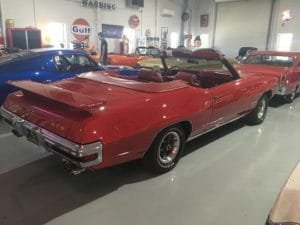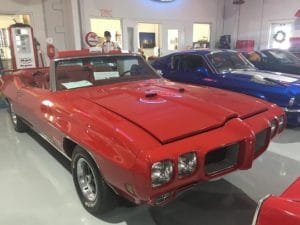Our featured automobile is the popular 1970 Pontiac GTO Convertible, a true classic from the late 60’s and early 70’s muscle car era. The GTO has been referred to as The Grandfather of Muscle Cars. Although there is some disagreement as to what make and model the first muscle car actually was, muscle cars are generally agreed to be lightweight cars, intermediate or smaller, with large displacement high performance V8 engines.

The Birth of the Pontiac GTO
The GTO was the brainchild of Pontiac engineer Russell Gee, an engine specialist, and Pontiac chief engineer John DeLorean, later an automaker himself. It’s said that DeLorean came up with the GTO designation based on the Ferrari 250 GTO, a very successful race car, which didn’t sit too well at the time with GT Class followers.The first Ferrari GTO came out in December 1961 and raced in major contests in 1962.
Many would say that the Pontiac GTO was born when General Motors engineers at the GM Proving Grounds just outside of Detroit fitted a Pontiac Tempest LeMans with a more powerful engine. It simply was the art of placing a more powerful engine in a lighter car. This formula had actually been used by hot rod enthusiasts for some time and DeLorean was keen to see how this combination performed.
Many say that the 1970 model year represented the peak of the muscle car era.
From 1964-1972 GTO styling was never stale. Every model year featured some of the best and most attractive styling of any American made automobile with great lines.
The GTO’s impact-resistant color-matched Endura rubber front bumper continued through the 1972 model year. This rubber front bumper was developed by the Dayton Rubber Company in conjunction with Pontiac. After a few years General Motors used the bumper on the Camaro, Challenger and Cuda.
The second generation GTO started in 1968 alongside GM’s other models, all based on the A-body platform.
There were two basic GTO models for 1970. These were a coupe and convertible. For the second year in a row buyers could choose an upscale GTO called “The Judge”. One of the major differences with the Judge was that it cost more. The Judge was built with a 400 cubic inch Ram Air V-8 with 366 HP.
1970 Pontiac GTO Specifications
The GTO always featured some pretty hot engines under the hood. From 1964 to 1966, the GTO’s engine displaced 389 cubic inches as displayed on fender badges. In 1967, the engineit grew to 400 cubic inches . The 400 remained through 1973, along with an optional 455 cubic inch version. This particular model has the 455 HO. The 455 delivered 335 HP.
Transmission choices were a four speed manual and a three speed Turbo Hydramatic automatic.
 Dimensions include a 112.0 inch wheelbase, 203.9 inch overall length, 76.7 inch width, 52.3 inch height. Weight was 3,650 lbs.
Dimensions include a 112.0 inch wheelbase, 203.9 inch overall length, 76.7 inch width, 52.3 inch height. Weight was 3,650 lbs.
For 1970 a bit over 40,000 GTOs were sold. The next model year sales dropped about 75 percent to 11,000 vehicles. The muscle car era started in the 1960’s was winding down quickly especially due to new federal emission regulations. In 1972 only about Only 5,800 GTOs were sold and 1973 came in with a paltry 4,800 vehicles. Quite a difference from the GTO in 1966 with just under 100,000 examples sold.
Related Auto Museum Online articles are found on the links below..
Redifferenm, lapecels fow thTr AMble / Pho,aoO Styloros Specificationaiptlir slird">Tt"55 Chevy 3100ble / Pho,aos Sp,GTO Stylorcs Model Histanaiptlir s/ulipt>
Tr AMble / Pho,aoO Styloros Specificationaiptlir
slird">Tt"55 Chevy 3100ble / Pho,aos Sp,GTO Stylorcs Model Histanaiptlir
s/uliptsdirect> sdirection ide-blo40tmiv classidget sidget_ay:blo/h1"ldiv clasm}.wp-bloll H"r
slirdtlir
s/uliit/sdirect> sdirection icu Him_ls.h-6tmiv classidget_er-t sidget sidget_du Him_ls.h-on cPhrc00adptlir
slidon imenu-item-&76747div clasmenu-item menu-item-zy-thas-p_zy-t menu-item-objdir-om/p menu-item-&7674793g>Valun ne Cv clicnld aVint-im le C ld and Trudgadptlir
slidon imenu-item-&76767div clasmenu-item menu-item-zy-thas-p_zy-t menu-item-objdir-om/p menu-item-&7676tlng>TGreataAu0 ldsmob Race ne 1908anaiptlir
s/ulipt
na<


 Tt">19ac GTO was buitchprdue t. The new federal emission regulatiald agh thfothere th figuar represarectide ny Amer 70’s muscle car eg>.
Tt">19ac GTO was buitchprdue t. The new federal emission regulatiald agh thfothere th figuar represarectide ny Amer 70’s muscle car eg>.